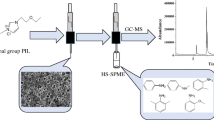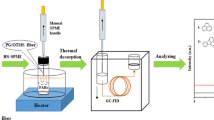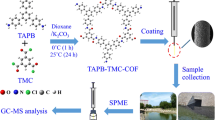Abstract
Short-chain aliphatic aldehydes are hazardous environmental pollutants and important biomarkers of various diseases. The development of effective methods for the determination of short-chain aliphatic aldehydes in samples with complex matrices remains an urgent task owing to their harmful effects on living organisms. To choose the optimal method of sample preparation, two types of derivatization of C1–C5 aliphatic aldehydes, in-solution and on-fiber, with O-(2,3,4,5,6-Pentafluorobenzyl)hydroxylamine are compared in this work in combination with headspace solid phase microextraction and GC/FID detection. Research on a limited number of analytes of one homologous series, C1–C5 aliphatic aldehydes, and detailed optimization of microextraction and derivatization parameters can significantly increase the extraction recovery, enrichment factors, and improve the sensitivity of the method. It was demonstrated that headspace solid phase microextraction with in-solution derivatization is more effective than with on-fiber derivatization. The extraction recovery of C3–C5 aldehydes was above 70%, and the enrichment factor was more than 7.5 × 103 for C1–C5 aldehydes. The developed method allows to detect C1–C5 aliphatic aldehydes with limits of detection from 100 to 400 ng L−1. The method is simple and fast, and meets the requirements of “green chemistry.” Tap water was analyzed for aliphatic aldehydes C1–C5 using the developed method. It was shown that the formaldehyde concentration was less than the environmental quality standards for fresh water (EU). In addition, it has been established that the formation of oximes takes place simultaneously on-fiber and in-solution during headspace solid phase microextraction with on-fiber derivatization. Primarily, it concerns the derivatives of short-chain aliphatic aldehydes.









Similar content being viewed by others
References
Baños CE, Silva M (2009) In situ continuous derivatization/pre-concentration of carbonyl compounds with 2,4-dinitrophenylhydrazine in aqueous samples by solid phase extraction. Application to liquid chromatography determination of aldehydes. Talanta 77(5):1597–1602. https://doi.org/10.1016/j.talanta.2008.09.053
Bao M, Joza PJ, Masters A, Rickert WS (2014) Analysis of selected carbonyl compounds in tobacco samples by using pentafluorobenzylhydroxylamine derivatization and gas chromatography-mass spectrometry. Contrib Tob Res 26(3):86–97. https://doi.org/10.2478/cttr-2014-001
Beránek J, Kubátová A (2008) Evaluation of solid phase microextraction methods for determination of trace concentration aldehydes in aqueous solution. J Chromatogr A 1209(1–2):44–54. https://doi.org/10.1016/j.chroma.2008.09.013
Calejo I, Moreira N, Araújo AM, Carvalho M, de Lourdes BM, de Pinho PG (2016) Optimisation and validation of a HS-SPME–GC–IT/MS method for analysis of carbonyl volatile compounds as biomarkers in human urine: application in a pilot study to discriminate individuals with smoking habits. Talanta 148:486–493. https://doi.org/10.1016/j.talanta.2015.09.070
Czaplicka M, Jaworek K, Wochnik A (2014) Determination of aldehydes in wet deposition. Arch Environ Prot 40(2):21–31. https://doi.org/10.2478/aep-2014-0011
Da Cunha Veloso MC, Da Silva VM, Santos GV, De Andrade JB (2001) Determination of aldehydes in fish by high-performance liquid chromatography. J Chromatogr Sci 39(5):173–176. https://doi.org/10.1093/chromsci/39.5.173
Da̧browska A, Nawrocki J, Szela̧g-Wasielewska E (2014) Appearance of aldehydes in the surface layer of lake waters. Environ Monit Assess 186(7):4569–4580. https://doi.org/10.1007/s10661-014-3720-y
Dennenlöhr J, Thörner S, Maxminer J, Rettberg N (2020) Analysis of selected staling aldehydes in wort and beer by GC-EI-MS/MS Using HS-SPME with on-fiber derivatization. J Am Soc Brew Chem 78(4):284–298. https://doi.org/10.1080/03610470.2020.1795478
Giokas DL, Tsogas GZ, Vlessidis AG (2009) On-line derivatization coupled to flow injection permanganate chemiluminescence detection of total carbonyl compounds in natural waters and drinking water. Anal Chim Acta 651(2):188–195. https://doi.org/10.1016/j.aca.2009.08.028
Ioannidou MD, Samouris G, Achilias DS (2016) Acetaldehyde contamination of water, alcoholic, and non-alcoholic beverages stored in glass or plastic bottles. Toxicol Environ Chem 98(10):1183–1190. https://doi.org/10.1080/02772248.2015.1115505
Li Y, Yi F, Zheng Y, Wang Y, Ye J, Chu Q (2015) Hollow-fiber liquid-phase microextraction coupled with miniature capillary electrophoresis for the trace analysis of four aliphatic aldehydes in water samples. J Sep Sci 38(16):2873–2879. https://doi.org/10.1002/jssc.201500323
Moreira N, Meireles S, Brandão T, De Pinho PG (2013) Optimization of the HS-SPME-GC-IT/MS method using a central composite design for volatile carbonyl compounds determination in beers. Talanta 117:523–531. https://doi.org/10.1016/j.talanta.2013.09.027
Moreira N, Araújo AM, Rogerson F, Vasconcelos I, De Freitas V, De Pinho PG (2019) Development and optimization of a HS-SPME-GC-MS methodology to quantify volatile carbonyl compounds in Port wines. Food Chem 270:518–526. https://doi.org/10.1016/j.foodchem.2018.07.093
Morés L, Dias AN, Carasek E (2018) Development of a high-throughput method based on thin-film microextraction using a 96-well plate system with a cork coating for the extraction of emerging contaminants in river water samples. J Sep Sci 41(3):697–703. https://doi.org/10.1002/jssc.201700774
Mosendz A, Levchyk V, Zui M (2021) The preconcentration of aromatic aldehydes on polydimethylsiloxane-divinylbenzene fiber. Mol Cryst Liq Cryst 719(1):71–83. https://doi.org/10.1080/15421406.2020.1862462
Munch JV et al (1999) US EPA Method 556.1: Determination of carbonyl compounds in drinking water by fast gas chromatography. Revision 1. Cincinnati, Ohio 45268, pp. 1–38. https://www.epa.gov/sites/default/files/2015-06/documents/epa-556.1.pdf
Ortiz RM (2015) Analysis of selected aldehydes in packaged beer by solid-phase microextraction (SPME)–gas chromatography (GC)–negative chemical ionization mass spectrometry (NCIMS). J Am Soc Brew Chem 73(3):266–274. https://doi.org/10.1094/ASBCJ-2015-0430-01
Poli D et al (2010) Determination of aldehydes in exhaled breath of patients with lung cancer by means of on-fiber-derivatisation SPME-GC/MS. J Chromatogr B Anal Technol Biomed Life Sci 878(27):2643–2651. https://doi.org/10.1016/j.jchromb.2010.01.022
Rodigast M, Mutzel A, Iinuma Y, Haferkorn S, Herrmann H (2015) Characterisation and optimisation of a sample preparation method for the detection and quantification of atmospherically relevant carbonyl compounds in aqueous medium. Atmos Meas Tech 8(6):2409–2416. https://doi.org/10.5194/amt-8-2409-2015
Rousová J, Chintapalli MR, Lindahl A, Casey J, Kubátová A (2018) Simultaneous determination of trace concentrations of aldehydes and carboxylic acids in particulate matter. J Chromatogr A 1544:49–61. https://doi.org/10.1016/j.chroma.2018.02.026
Sarkar C, Sinha V, Kumar V et al (2016) Overview of VOC emissions and chemistry from PTR-TOF-MS measurements during the SusKat-ABC campaign: high acetaldehyde, isoprene and isocyanic acid in wintertime air of the Kathmandu Valley. Atmos Chem Phys 16(6):3979–4003. https://doi.org/10.5194/acp-16-3979-2016
Serrano M, Silva M, Gallego M (2013) Development of an environment-friendly microextraction method for the determination of aliphatic and aromatic aldehydes in water. Anal Chim Acta 784:77–84. https://doi.org/10.1016/j.aca.2013.04.059
Spietelun A, Pilarczyk M, Kloskowski A, Namieśnik J (2010) Current trends in solid phase microextraction (SPME) fibre coatings. Chem Soc Rev 39(11):4524–4537. https://doi.org/10.1039/c003335a
Supelco Bulletin 928A (2004). Solid Phase Microextraction Troubleshooting Guide. Sigma-Aldrich Co. https://www.sigmaaldrich.com/content/dam/sigma-aldrich/docs/Supelco/General_Information/1/t101928.pdf.
US EPA Method 8315A Determination of carbonyl compounds by high performance liquid chromatography (HPLC). EPA Methods, 1996, pp 1–34. https://www.epa.gov/sites/default/files/2015-07/documents/epa-8315a.pdf
Wang Q, O’Reilly J, Pawliszyn J (2005) Determination of low-molecular mass aldehydes by automated headspace solid phase microextraction with in-fibre derivatisation. J Chromatogr A 1071(1–2):147–154. https://doi.org/10.1016/j.chroma.2004.09.031
Zakharkiv I, Zui M, Zaitsev V (2015) Preconcentration of aliphatic aldehydes C1–C5 As O-(2,3,4,5,6-pentafluorobenzyl)hydroxylamine derivatives by dispersive liquid–phase microextraction. Methods Objects Chem Anal 10(3):113–118. https://doi.org/10.17721/moca.2015.113-118
Zhang Y, Zhao D, Wang B, Liang Z, Chen Y, Meng B, Shang S (2015) Determination of aldehydes in environmental water by solid phase microextraction and gas chromatography—ion trap mass spectrometry. Instrum Sci Technol 43(3):344–356. https://doi.org/10.1080/10739149.2014.1002041
Zhang Z, Yan X, Gao F, Thai P, Wang H, Chen D, Zhou L, Gong D, Li Q, Morawska L, Wang B (2018) Emission and health risk assessment of volatile organic compounds in various processes of a petroleum refinery in the Pearl River Delta, China. Environ Pollut 238:452–461. https://doi.org/10.1016/j.envpol.2018.03.054
Acknowledgments
The authors would like to thank the LLC “ALSI-CHROM”, Kyiv, Ukraine, especially, Dr. Esaulenko Andriy, Director of the LLC “ALSI-CHROM” for financial support of this research.
Author information
Authors and Affiliations
Corresponding author
Ethics declarations
Conflict of interest
On behalf of all authors, the corresponding author states that there is no conflict of interest.
Additional information
Publisher's Note
Springer Nature remains neutral with regard to jurisdictional claims in published maps and institutional affiliations.
Rights and permissions
Springer Nature or its licensor (e.g. a society or other partner) holds exclusive rights to this article under a publishing agreement with the author(s) or other rightsholder(s); author self-archiving of the accepted manuscript version of this article is solely governed by the terms of such publishing agreement and applicable law.
About this article
Cite this article
Zakharkiv, I., Zui, M. & Zaitsev, V. Determination of aliphatic aldehydes C1–C5 with headspace solid phase microextraction in tap water: derivatization in-solution versus on-fiber. Chem. Pap. 78, 435–445 (2024). https://doi.org/10.1007/s11696-023-03100-y
Received:
Accepted:
Published:
Issue Date:
DOI: https://doi.org/10.1007/s11696-023-03100-y




